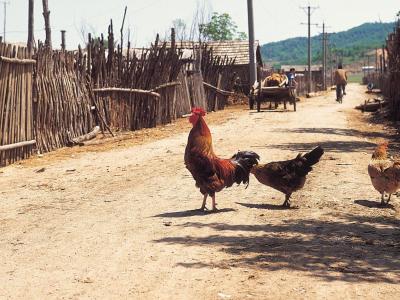French veterinary officials today said the highly pathogenic H5N8 avian flu strain spreading quickly though Europe has been detected for the first time in the country's poultry in the south.
Also South Korea is reporting several new outbreaks of H5N6 avian flu, which, according to a new report from China, has replaced H5N1 as the dominant strain in that country's poultry.
French outbreak strikes foie gras ducks
In a report today to the World Organization for Animal Health (OIE), France's agriculture ministry said H5N8 struck an open-air farm in Tarn department that raises ducks for foie gras production. An increase in duck deaths was noted on Nov 25, and samples taken on Nov 28 yielded positive results for H5N8 yesterday.
The virus killed 2,000 of 5,143 ducks, and the remaining birds will be culled today, as well as those on a nearby farm as a precautionary measure.
Tarn is located in southwestern France, in an area that saw its foie gras industry hit hard this time last year by outbreaks of highly pathogenic H5N1, H5N2, and H5N9.
France's first detection of the H5N8 strain came about a week ago when the virus turned up in wild ducks in Pas de Calais department in northern France.
H5N6 expands in South Korea
In H5N6 developments in Asia, South Korea today reported six more outbreaks in two provinces where the virus has already struck poultry: Chungcheong and South Jeolla.
According to a report to the OIE, the outbreaks began on Nov 21 and Nov 22 at farms housing 53,024 birds. Officials didn't include the number of poultry deaths but said the birds were stamped out to curb the spread of the virus.
In Japan, where H5N6 has already been confirmed in poultry in two prefectures, the environmental ministry said it is investigating avian flu detections in five more: Fukushima, Hyogo, Miyagi, Iwate, and Ibaraki, according to a government statement translated and posted by Avian Flu Diary (AFD), an infectious disease news blog.
It's not clear yet if the detections involve H5N6. The eight new events in the Japanese government report involve wild birds, protected birds, and poultry.
In Taiwan, which is on the same migratory pathway as the birds thought to have spread H5N6 from China to South Korea and Japan, enhanced surveillance has found several low-pathogenic H5 and H7 avian flu viruses in environmental samples collected from area wetlands. The Bureau of Animal Plant Health Inspection and Quarantine detailed the findings in a report translated and posted by AFD.
In their report, the Taiwanese officials urged poultry producers to enhance their biosecurity measures.
Chinese team warns of H5N6 threat
Researchers from China who tested birds at live-poultry markets from 2014 to 2016 to assess what subtypes are circulating and how they are evolving reported their findings yesterday in Cell Host and Microbe. They based their analysis on 3,174 samples and sequences from 1,135 of the viruses.
H5N6 was first detected in Laos in 2013, then spread to China and Vietnam, according to the report. The virus is a novel reassortant between H5N1 and H6N6 and has caused 17 human illnesses in China since 2014.
The virus has become one of the dominant subtype in southern China, especially in ducks, replacing H5N1, the group wrote. Their genetic analysis showed 34 distinct H5N6 genotypes, including 4 that have infected people. One of the 4 was linked to five human illnesses.
Though waterfowl are the natural reservoirs of avian flu virus and play a role in their geographic reach, China's live-poultry trade enhances their transmission and spread, and the team noted that almost all of the people infected with H5N6 had exposure to poultry or live markets, underscoring the importance of infection prevention in those settings.
Chickens vaccinated against H5N1, routinely done in the country, show protection against H5N6 but still shed the live virus. The authors said a large number of healthy birds sampled in the study were positive for H5N6, revealing flaws in current vaccination strategies.
The researchers wrote that broad distribution of H5N6 in China and Southeast Asia increases the threat to humans, and they said studies have hinted that the virus has increased capacity to bind to human receptors and increased transmissibility in mammals.
"These findings combined with our results demonstrate that H5N6 viruses pose a considerable threat to public health despite the limited number of human cases," they concluded.
See also:
Dec 2 OIE report on H5N8 at French duck farm
Dec 2 OIE report on more H5N6 outbreaks in South Korea
Dec 2 AFD post on avian flu in Japan
Dec 2 AFD post on avian flu in Taiwan
Dec 1 Cell Host Microbe abstract




















